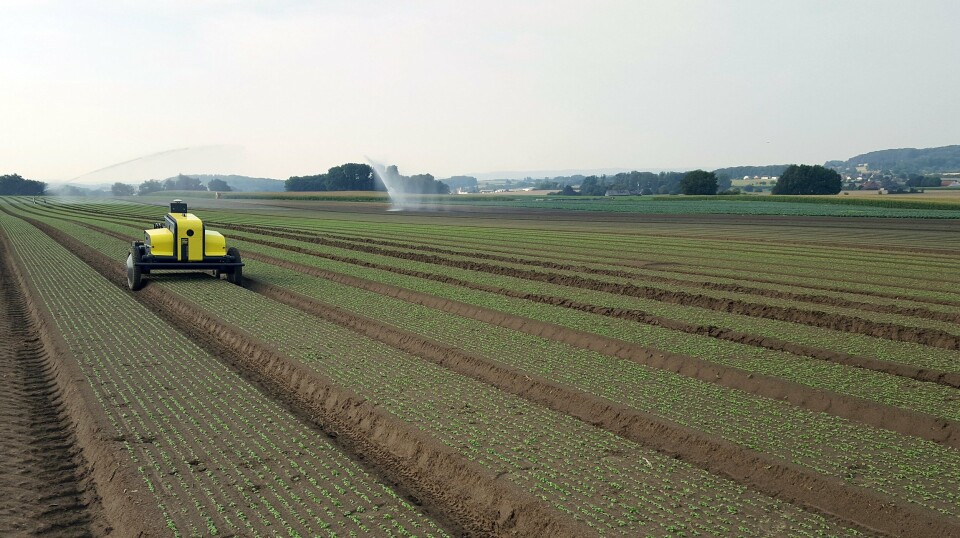
Robots ensure more and better vegetables to eat with fewer toxins to harm the environment
Robots are taking over Norwegian vegetable fields. The AX-1 robot ensures better crops with fewer herbicides.
The first robots are already rolling on Norwegian soil. Some of them are making sure there are more vegetables to eat with fewer toxins to harm the environment.
“There are eight robots in operation this season. Last year we sold two to that are operating in Rygge, and this year we have produced and sold six more,” Vegard Line said to sciencenorway.no.
Difficult to spray

Line develops and sells robots that apply herbicides as part of the new company Kilter. Its parent company Adigo developed the robots, with help from the EU-funded research project Asterix.
“This is a project that we have been working on for more than ten years. When we went from research and development to commercialization, we set up the project as a separate company,” said Øyvind Overskeid, general manager at Adigo.
He explains the difficult balancing act that’s required to control weeds where you grow food.
“Today, herbicides are designed to kill one plant and allow another to survive. There are so many vegetable varieties that no one develops herbicides specifically for each individual vegetable type,” he says.
The herbicides on the market today kill weeds, but at the same time weaken vegetables. This makes the vegetables more vulnerable to insects and diseases.
Recognizes the leaves
When the farmer sprays, there is a mist of small drops that covers the entire field — meaning the herbicide covers both useful plants and weeds.
The Kilter AX-1 spray robot takes a completely different approach: It shoots out a single drop. One drop is enough to dry out the leaf it lands on.
“We have software that recognizes each individual leaf and determines which species it is. Then we have patented a nozzle system that shoots out one drop at a time,” Overskeid said to sciencenorway.no.
Natural remedy
The robot divides the entire field into a six-by-six millimetres grid so it can treat the correct leaf. Then it sprays the plants with geranium acid, a substance that harms the plants, but not the environment. It is found naturally in milk, potatoes and pork, among other things.
“It’s a fatty acid; you could say that it is a cousin of acetic acid. It breaks down quite naturally in the ground, and isn’t toxic. What it does is remove the wax layer on the leaves so that they dry out,” Overskeid explains.
Kilter specializes in vegetables. Grains are grown over such large areas that each variety is protected with specialized herbicides. Vegetables occupy smaller areas, but are at the same time more valuable per unit area.

Increased by 30 per cent
After the robot was developed, the research institute Nibio conducted experiments and compared the crop results.
“We saw extreme increases in crop yields. The yield of parsley root increased by 30 per cent where we used the robot compared to regular, traditional treatment,” Overskeid said.
The price that farmers will have to pay for the robot has not yet been set, however.
“We have built up a production line to learn what we should put aside, what we should do ourselves, how much time it takes and how much it costs. We have learned a lot, but we are still not entirely sure what the price will be,” Line said.
He thinks that the robot will be affordable and cost a good deal less than an average tractor, for example. Maybe around a million NOK.
“We will have a price that is affordable for the farmer,” Line said.

Extremely tough competition
In any case, it won’t be very long before you will see many different robots working on Norwegian soil.

“We will see them very soon. Not in five to ten years — before then,” said Pål Johan From.
From is a professor at NMBU, the Norwegian University of Life Sciences. His research there involves working with Thorvald, a robot that treats strawberries with UV light to keep them healthy, and that soon will also be able to pick a berry exactly when it's at its best.
- Read more about this robot in a press release from NMBU: How robots find the best food
“Everything from precision spraying to mechanical weeding to more precise weed removal represents a gigantic market. This is where we see by far the most robots, both at the prototype stage and commercially,” From said to sciencenorway.no.
He says that right now it’s possible to order a robot, but that there are long waiting lists.
“We have a good number of robots already working with strawberries. For weeding, I would guess that robots will be coming soon. We hope that Asterix will be the robot on offer — that they can develop it quickly enough that it becomes a Norwegian robot that operates on Norwegian land. There’s a huge amount of competition in this field,” says the professor.
Translated by Nancy Bazilchuk
Reference:
Trygve Utstumo et.al.: Robotic in-row weed control in vegetables. Computers and Electronics in Agriculture, 2018. (Summary)
———
Read the Norwegian version of this article at forskning.no
































